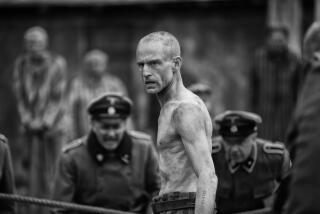The Creativity of ‘The Civil War’
- Share via
Ken Burns, creator of public TV’s “The Civil War,” once wanted to make movies. His hero: John Ford, the great director of Westerns.
“Here was a man who told stories in American history, stories with a social history to them,” he said. “He was concerned with the music, the place, the authenticity of the period as well as telling a story.”
Burns may have been inspired by Ford when he was a college kid, but still-photographers and documentary makers changed his life. “They showed me the real world was as dramatic, if not more dramatic than works of fiction.”
It eventually led to “The Civil War,” which achieved both acclaim and PBS’ highest-ever ratings for a series when it ran for five nights last September. It is now being repeated.
Much of the series’ power came from his fluid ability to bring Civil War photographs and paintings to life, looking first at the scope of the picture, then at a small, yet haunting detail, like a soldier’s haggard face.
Many of today’s video-fluent generation would put a still photo on TV only as a last resort.
Not Burns. With a photo of, say, Babe Ruth, “I can fade in searchingly into his eyes, and speak volumes. A newsreel is very dramatic and compelling, but it only sounds one note. A photograph can be a chord.”
Burns has had lean times. He recalls living on peanut butter sandwiches and the floors of friends’ apartments while making his first major documentary “Brooklyn Bridge.” Things are much better now, of course.
Still, it’s likely that public TV’s wardens would have granted him a full pardon had he taken his “Civil War” huzzahs and run for the nearest network to turn them into big dough, maybe even a miniseries starring Robert Urich.
He wouldn’t do it, he said. It’s not so much a matter of principle as it is commercial TV’s frequent pauses for commercial blizzards:
“I just think the whole game of history, the whole game of anything that’s meaningful, is based on attention. You can’t have attention if every six or eight minutes you’re going to stop and sell soap.
“All meaning accrues in duration. Period. A photograph held for a split second by MTV can be received by the brain ... but if you hold that photograph (longer), the meaning deepens. So, too, with any experiences.”
He has thought of feature films, though. He visited Hollywood in January, and reports hearing courting sounds from studios chiefs there.
No deals, but he may some day try Hollywood. Documentaries remain his main event, though, and he is immensely grateful that General Motors underwrote--a PBS word for bankrolled--most of the 11-hour “The Civil War” series and heavily promoted it.
GM also is underwriting his two new PBS efforts, the first of which is the two-hour “Empire of the Air,” due Jan. 29, he said.
He said it’s a “dark, 20th-Century tale” about three U.S. radio pioneers--inventors Lee deForest and Edwin Howard Armstrong, and RCA boss David Sarnoff, who made NBC what it once was.
The other work, a series still in progress and without a title right now, is about major league baseball in America, both as a societal weather vane and as a grand old game.
He said General Motors’ support for “The Civil War,” a five-year effort, totaled $3.2 million, plus another $500,000 for accompanying educational projects such as teacher guides and materials for students.
The public’s response, he contends, makes a compelling argument for other companies to underwrite other shows in public TV--which, like its commercial cousins, is suffering lean times.
“If you look at the return GM has gotten through its (TV) impressions and good will and good faith through what I was doing, it’s enormous.”
“The Civil War” airs Wednesdays at 8 p.m., with repeats Sundays at noon, on KCET, and Wednesdays at 9 p.m., with repeats Sundays at 1 p.m., on KPBS.
More to Read
The complete guide to home viewing
Get Screen Gab for everything about the TV shows and streaming movies everyone’s talking about.
You may occasionally receive promotional content from the Los Angeles Times.






